Transition to Professional Role: Challenges in Healthcare
VerifiedAdded on 2022/12/23
|12
|3165
|56
Essay
AI Summary
This essay identifies the challenges encountered during the transition from nursing training to professional clinical practice, focusing on the gap between education and clinical practice, functionality defects, communication issues, and managerial unpreparedness. It proposes strategies to facilitate adjustment, including mandatory internship programs and mentorship, to address these challenges. The essay argues that these strategies can better prepare new graduates for the workforce by closing the education-practice gap, improving communication skills, and fostering responsibility. It also emphasizes the importance of NMBA documentation and evidence-based practice in promoting health and well-being.
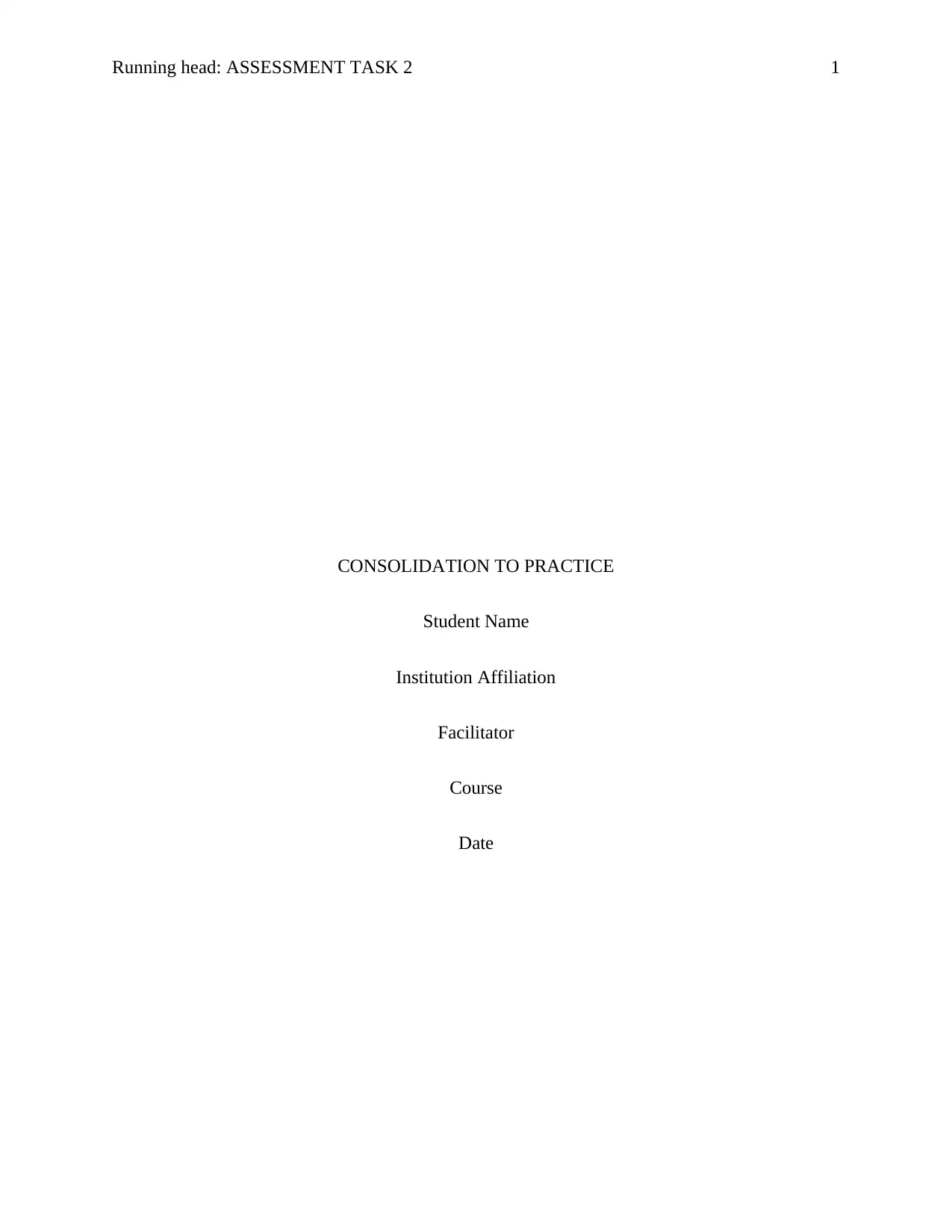
Running head: ASSESSMENT TASK 2 1
CONSOLIDATION TO PRACTICE
Student Name
Institution Affiliation
Facilitator
Course
Date
CONSOLIDATION TO PRACTICE
Student Name
Institution Affiliation
Facilitator
Course
Date
Paraphrase This Document
Need a fresh take? Get an instant paraphrase of this document with our AI Paraphraser
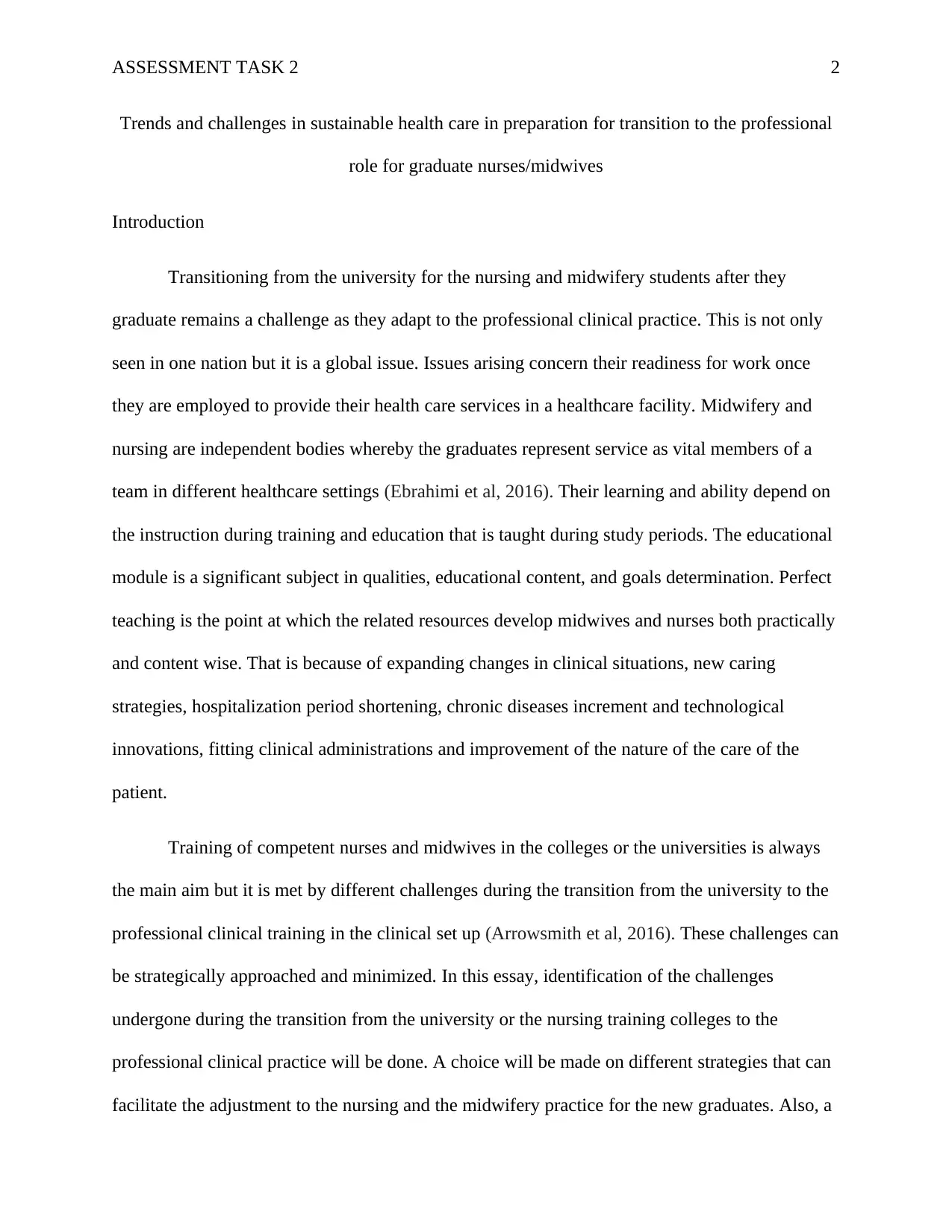
ASSESSMENT TASK 2 2
Trends and challenges in sustainable health care in preparation for transition to the professional
role for graduate nurses/midwives
Introduction
Transitioning from the university for the nursing and midwifery students after they
graduate remains a challenge as they adapt to the professional clinical practice. This is not only
seen in one nation but it is a global issue. Issues arising concern their readiness for work once
they are employed to provide their health care services in a healthcare facility. Midwifery and
nursing are independent bodies whereby the graduates represent service as vital members of a
team in different healthcare settings (Ebrahimi et al, 2016). Their learning and ability depend on
the instruction during training and education that is taught during study periods. The educational
module is a significant subject in qualities, educational content, and goals determination. Perfect
teaching is the point at which the related resources develop midwives and nurses both practically
and content wise. That is because of expanding changes in clinical situations, new caring
strategies, hospitalization period shortening, chronic diseases increment and technological
innovations, fitting clinical administrations and improvement of the nature of the care of the
patient.
Training of competent nurses and midwives in the colleges or the universities is always
the main aim but it is met by different challenges during the transition from the university to the
professional clinical training in the clinical set up (Arrowsmith et al, 2016). These challenges can
be strategically approached and minimized. In this essay, identification of the challenges
undergone during the transition from the university or the nursing training colleges to the
professional clinical practice will be done. A choice will be made on different strategies that can
facilitate the adjustment to the nursing and the midwifery practice for the new graduates. Also, a
Trends and challenges in sustainable health care in preparation for transition to the professional
role for graduate nurses/midwives
Introduction
Transitioning from the university for the nursing and midwifery students after they
graduate remains a challenge as they adapt to the professional clinical practice. This is not only
seen in one nation but it is a global issue. Issues arising concern their readiness for work once
they are employed to provide their health care services in a healthcare facility. Midwifery and
nursing are independent bodies whereby the graduates represent service as vital members of a
team in different healthcare settings (Ebrahimi et al, 2016). Their learning and ability depend on
the instruction during training and education that is taught during study periods. The educational
module is a significant subject in qualities, educational content, and goals determination. Perfect
teaching is the point at which the related resources develop midwives and nurses both practically
and content wise. That is because of expanding changes in clinical situations, new caring
strategies, hospitalization period shortening, chronic diseases increment and technological
innovations, fitting clinical administrations and improvement of the nature of the care of the
patient.
Training of competent nurses and midwives in the colleges or the universities is always
the main aim but it is met by different challenges during the transition from the university to the
professional clinical training in the clinical set up (Arrowsmith et al, 2016). These challenges can
be strategically approached and minimized. In this essay, identification of the challenges
undergone during the transition from the university or the nursing training colleges to the
professional clinical practice will be done. A choice will be made on different strategies that can
facilitate the adjustment to the nursing and the midwifery practice for the new graduates. Also, a
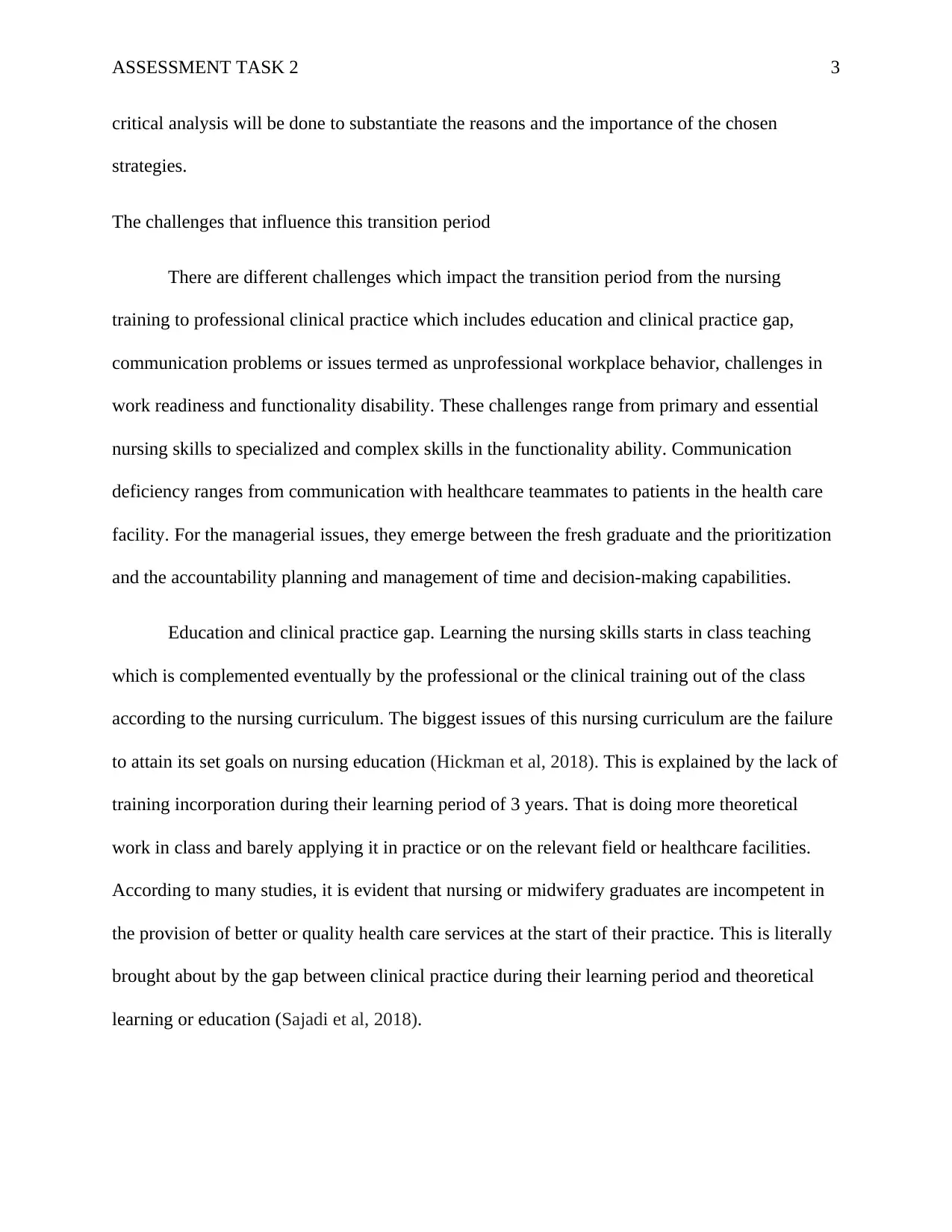
ASSESSMENT TASK 2 3
critical analysis will be done to substantiate the reasons and the importance of the chosen
strategies.
The challenges that influence this transition period
There are different challenges which impact the transition period from the nursing
training to professional clinical practice which includes education and clinical practice gap,
communication problems or issues termed as unprofessional workplace behavior, challenges in
work readiness and functionality disability. These challenges range from primary and essential
nursing skills to specialized and complex skills in the functionality ability. Communication
deficiency ranges from communication with healthcare teammates to patients in the health care
facility. For the managerial issues, they emerge between the fresh graduate and the prioritization
and the accountability planning and management of time and decision-making capabilities.
Education and clinical practice gap. Learning the nursing skills starts in class teaching
which is complemented eventually by the professional or the clinical training out of the class
according to the nursing curriculum. The biggest issues of this nursing curriculum are the failure
to attain its set goals on nursing education (Hickman et al, 2018). This is explained by the lack of
training incorporation during their learning period of 3 years. That is doing more theoretical
work in class and barely applying it in practice or on the relevant field or healthcare facilities.
According to many studies, it is evident that nursing or midwifery graduates are incompetent in
the provision of better or quality health care services at the start of their practice. This is literally
brought about by the gap between clinical practice during their learning period and theoretical
learning or education (Sajadi et al, 2018).
critical analysis will be done to substantiate the reasons and the importance of the chosen
strategies.
The challenges that influence this transition period
There are different challenges which impact the transition period from the nursing
training to professional clinical practice which includes education and clinical practice gap,
communication problems or issues termed as unprofessional workplace behavior, challenges in
work readiness and functionality disability. These challenges range from primary and essential
nursing skills to specialized and complex skills in the functionality ability. Communication
deficiency ranges from communication with healthcare teammates to patients in the health care
facility. For the managerial issues, they emerge between the fresh graduate and the prioritization
and the accountability planning and management of time and decision-making capabilities.
Education and clinical practice gap. Learning the nursing skills starts in class teaching
which is complemented eventually by the professional or the clinical training out of the class
according to the nursing curriculum. The biggest issues of this nursing curriculum are the failure
to attain its set goals on nursing education (Hickman et al, 2018). This is explained by the lack of
training incorporation during their learning period of 3 years. That is doing more theoretical
work in class and barely applying it in practice or on the relevant field or healthcare facilities.
According to many studies, it is evident that nursing or midwifery graduates are incompetent in
the provision of better or quality health care services at the start of their practice. This is literally
brought about by the gap between clinical practice during their learning period and theoretical
learning or education (Sajadi et al, 2018).
⊘ This is a preview!⊘
Do you want full access?
Subscribe today to unlock all pages.

Trusted by 1+ million students worldwide
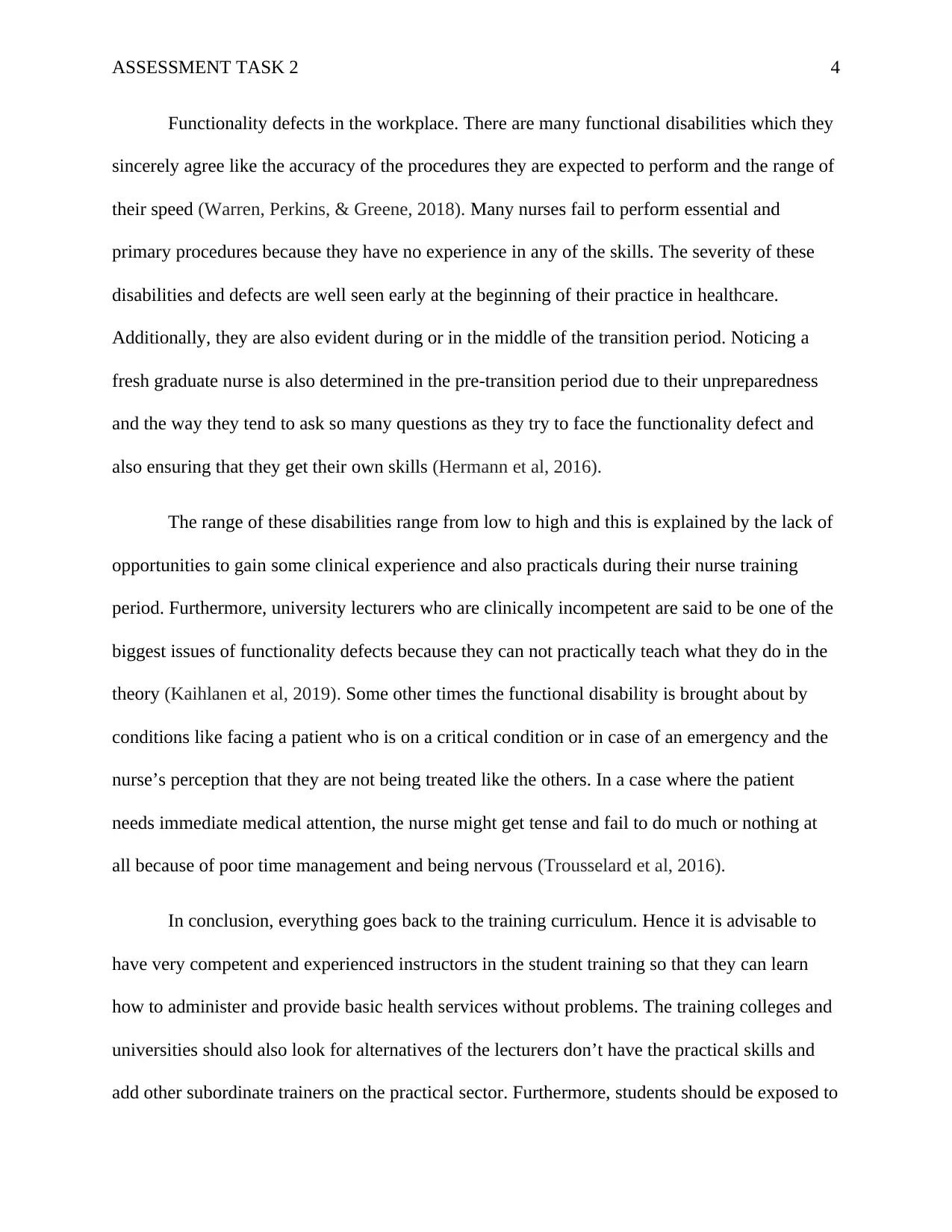
ASSESSMENT TASK 2 4
Functionality defects in the workplace. There are many functional disabilities which they
sincerely agree like the accuracy of the procedures they are expected to perform and the range of
their speed (Warren, Perkins, & Greene, 2018). Many nurses fail to perform essential and
primary procedures because they have no experience in any of the skills. The severity of these
disabilities and defects are well seen early at the beginning of their practice in healthcare.
Additionally, they are also evident during or in the middle of the transition period. Noticing a
fresh graduate nurse is also determined in the pre-transition period due to their unpreparedness
and the way they tend to ask so many questions as they try to face the functionality defect and
also ensuring that they get their own skills (Hermann et al, 2016).
The range of these disabilities range from low to high and this is explained by the lack of
opportunities to gain some clinical experience and also practicals during their nurse training
period. Furthermore, university lecturers who are clinically incompetent are said to be one of the
biggest issues of functionality defects because they can not practically teach what they do in the
theory (Kaihlanen et al, 2019). Some other times the functional disability is brought about by
conditions like facing a patient who is on a critical condition or in case of an emergency and the
nurse’s perception that they are not being treated like the others. In a case where the patient
needs immediate medical attention, the nurse might get tense and fail to do much or nothing at
all because of poor time management and being nervous (Trousselard et al, 2016).
In conclusion, everything goes back to the training curriculum. Hence it is advisable to
have very competent and experienced instructors in the student training so that they can learn
how to administer and provide basic health services without problems. The training colleges and
universities should also look for alternatives of the lecturers don’t have the practical skills and
add other subordinate trainers on the practical sector. Furthermore, students should be exposed to
Functionality defects in the workplace. There are many functional disabilities which they
sincerely agree like the accuracy of the procedures they are expected to perform and the range of
their speed (Warren, Perkins, & Greene, 2018). Many nurses fail to perform essential and
primary procedures because they have no experience in any of the skills. The severity of these
disabilities and defects are well seen early at the beginning of their practice in healthcare.
Additionally, they are also evident during or in the middle of the transition period. Noticing a
fresh graduate nurse is also determined in the pre-transition period due to their unpreparedness
and the way they tend to ask so many questions as they try to face the functionality defect and
also ensuring that they get their own skills (Hermann et al, 2016).
The range of these disabilities range from low to high and this is explained by the lack of
opportunities to gain some clinical experience and also practicals during their nurse training
period. Furthermore, university lecturers who are clinically incompetent are said to be one of the
biggest issues of functionality defects because they can not practically teach what they do in the
theory (Kaihlanen et al, 2019). Some other times the functional disability is brought about by
conditions like facing a patient who is on a critical condition or in case of an emergency and the
nurse’s perception that they are not being treated like the others. In a case where the patient
needs immediate medical attention, the nurse might get tense and fail to do much or nothing at
all because of poor time management and being nervous (Trousselard et al, 2016).
In conclusion, everything goes back to the training curriculum. Hence it is advisable to
have very competent and experienced instructors in the student training so that they can learn
how to administer and provide basic health services without problems. The training colleges and
universities should also look for alternatives of the lecturers don’t have the practical skills and
add other subordinate trainers on the practical sector. Furthermore, students should be exposed to
Paraphrase This Document
Need a fresh take? Get an instant paraphrase of this document with our AI Paraphraser
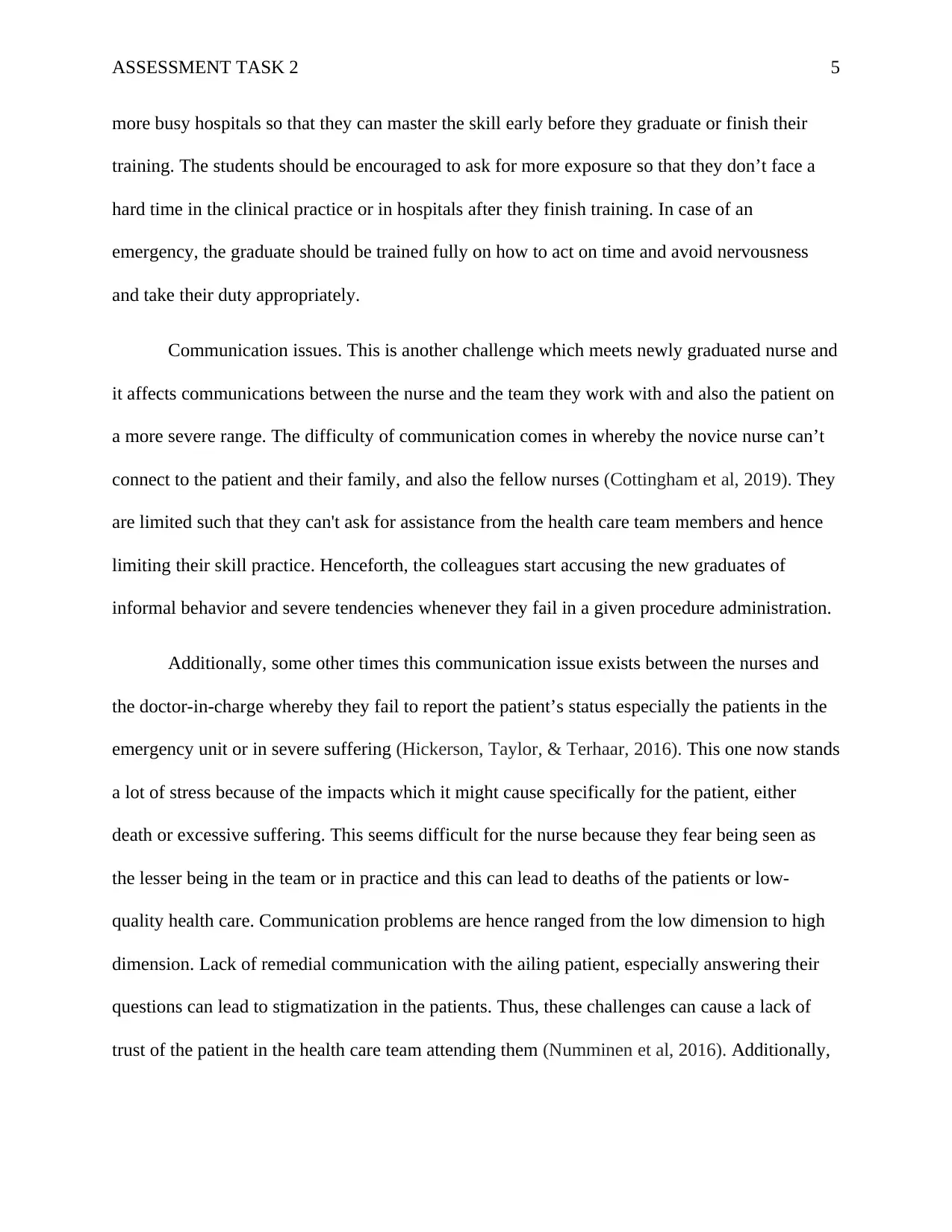
ASSESSMENT TASK 2 5
more busy hospitals so that they can master the skill early before they graduate or finish their
training. The students should be encouraged to ask for more exposure so that they don’t face a
hard time in the clinical practice or in hospitals after they finish training. In case of an
emergency, the graduate should be trained fully on how to act on time and avoid nervousness
and take their duty appropriately.
Communication issues. This is another challenge which meets newly graduated nurse and
it affects communications between the nurse and the team they work with and also the patient on
a more severe range. The difficulty of communication comes in whereby the novice nurse can’t
connect to the patient and their family, and also the fellow nurses (Cottingham et al, 2019). They
are limited such that they can't ask for assistance from the health care team members and hence
limiting their skill practice. Henceforth, the colleagues start accusing the new graduates of
informal behavior and severe tendencies whenever they fail in a given procedure administration.
Additionally, some other times this communication issue exists between the nurses and
the doctor-in-charge whereby they fail to report the patient’s status especially the patients in the
emergency unit or in severe suffering (Hickerson, Taylor, & Terhaar, 2016). This one now stands
a lot of stress because of the impacts which it might cause specifically for the patient, either
death or excessive suffering. This seems difficult for the nurse because they fear being seen as
the lesser being in the team or in practice and this can lead to deaths of the patients or low-
quality health care. Communication problems are hence ranged from the low dimension to high
dimension. Lack of remedial communication with the ailing patient, especially answering their
questions can lead to stigmatization in the patients. Thus, these challenges can cause a lack of
trust of the patient in the health care team attending them (Numminen et al, 2016). Additionally,
more busy hospitals so that they can master the skill early before they graduate or finish their
training. The students should be encouraged to ask for more exposure so that they don’t face a
hard time in the clinical practice or in hospitals after they finish training. In case of an
emergency, the graduate should be trained fully on how to act on time and avoid nervousness
and take their duty appropriately.
Communication issues. This is another challenge which meets newly graduated nurse and
it affects communications between the nurse and the team they work with and also the patient on
a more severe range. The difficulty of communication comes in whereby the novice nurse can’t
connect to the patient and their family, and also the fellow nurses (Cottingham et al, 2019). They
are limited such that they can't ask for assistance from the health care team members and hence
limiting their skill practice. Henceforth, the colleagues start accusing the new graduates of
informal behavior and severe tendencies whenever they fail in a given procedure administration.
Additionally, some other times this communication issue exists between the nurses and
the doctor-in-charge whereby they fail to report the patient’s status especially the patients in the
emergency unit or in severe suffering (Hickerson, Taylor, & Terhaar, 2016). This one now stands
a lot of stress because of the impacts which it might cause specifically for the patient, either
death or excessive suffering. This seems difficult for the nurse because they fear being seen as
the lesser being in the team or in practice and this can lead to deaths of the patients or low-
quality health care. Communication problems are hence ranged from the low dimension to high
dimension. Lack of remedial communication with the ailing patient, especially answering their
questions can lead to stigmatization in the patients. Thus, these challenges can cause a lack of
trust of the patient in the health care team attending them (Numminen et al, 2016). Additionally,
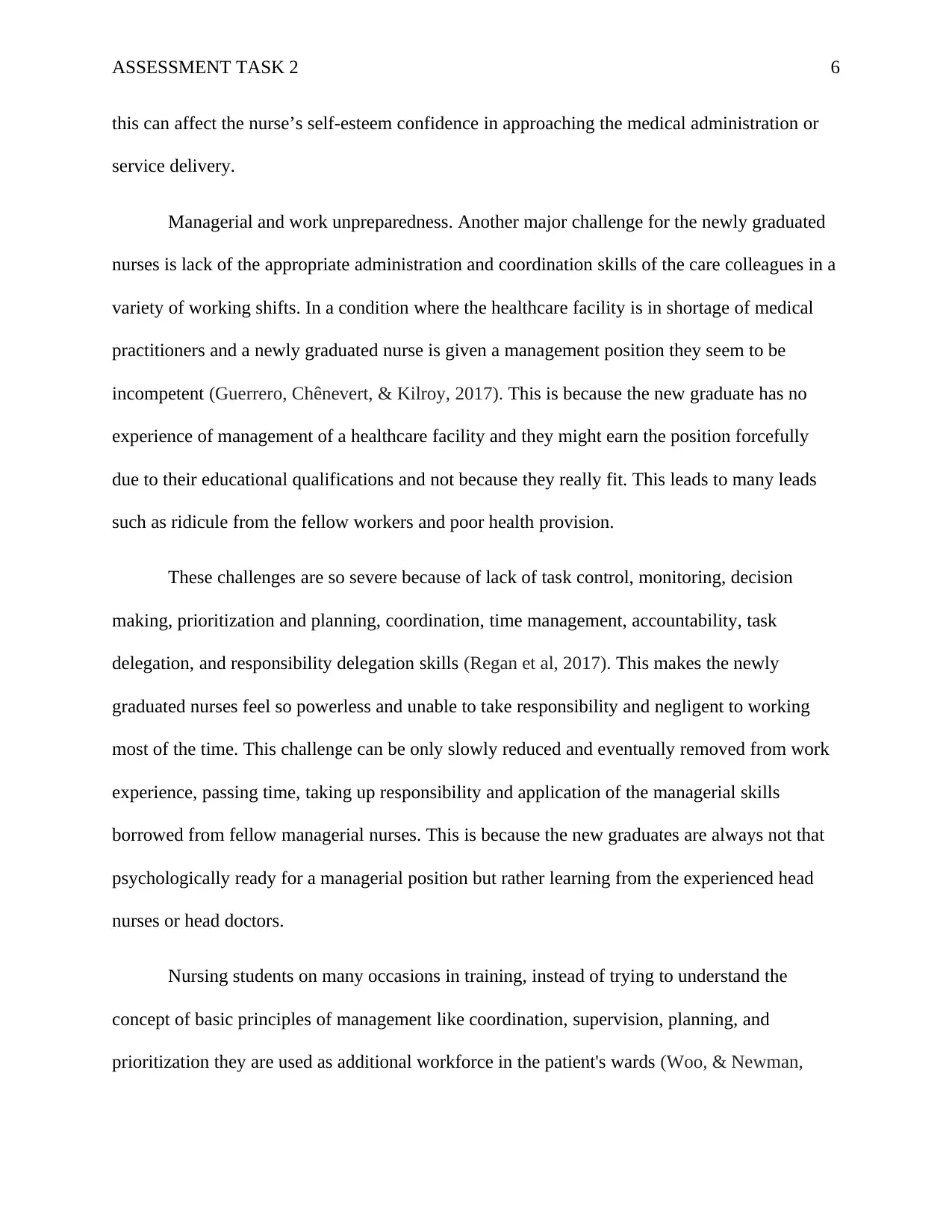
ASSESSMENT TASK 2 6
this can affect the nurse’s self-esteem confidence in approaching the medical administration or
service delivery.
Managerial and work unpreparedness. Another major challenge for the newly graduated
nurses is lack of the appropriate administration and coordination skills of the care colleagues in a
variety of working shifts. In a condition where the healthcare facility is in shortage of medical
practitioners and a newly graduated nurse is given a management position they seem to be
incompetent (Guerrero, Chênevert, & Kilroy, 2017). This is because the new graduate has no
experience of management of a healthcare facility and they might earn the position forcefully
due to their educational qualifications and not because they really fit. This leads to many leads
such as ridicule from the fellow workers and poor health provision.
These challenges are so severe because of lack of task control, monitoring, decision
making, prioritization and planning, coordination, time management, accountability, task
delegation, and responsibility delegation skills (Regan et al, 2017). This makes the newly
graduated nurses feel so powerless and unable to take responsibility and negligent to working
most of the time. This challenge can be only slowly reduced and eventually removed from work
experience, passing time, taking up responsibility and application of the managerial skills
borrowed from fellow managerial nurses. This is because the new graduates are always not that
psychologically ready for a managerial position but rather learning from the experienced head
nurses or head doctors.
Nursing students on many occasions in training, instead of trying to understand the
concept of basic principles of management like coordination, supervision, planning, and
prioritization they are used as additional workforce in the patient's wards (Woo, & Newman,
this can affect the nurse’s self-esteem confidence in approaching the medical administration or
service delivery.
Managerial and work unpreparedness. Another major challenge for the newly graduated
nurses is lack of the appropriate administration and coordination skills of the care colleagues in a
variety of working shifts. In a condition where the healthcare facility is in shortage of medical
practitioners and a newly graduated nurse is given a management position they seem to be
incompetent (Guerrero, Chênevert, & Kilroy, 2017). This is because the new graduate has no
experience of management of a healthcare facility and they might earn the position forcefully
due to their educational qualifications and not because they really fit. This leads to many leads
such as ridicule from the fellow workers and poor health provision.
These challenges are so severe because of lack of task control, monitoring, decision
making, prioritization and planning, coordination, time management, accountability, task
delegation, and responsibility delegation skills (Regan et al, 2017). This makes the newly
graduated nurses feel so powerless and unable to take responsibility and negligent to working
most of the time. This challenge can be only slowly reduced and eventually removed from work
experience, passing time, taking up responsibility and application of the managerial skills
borrowed from fellow managerial nurses. This is because the new graduates are always not that
psychologically ready for a managerial position but rather learning from the experienced head
nurses or head doctors.
Nursing students on many occasions in training, instead of trying to understand the
concept of basic principles of management like coordination, supervision, planning, and
prioritization they are used as additional workforce in the patient's wards (Woo, & Newman,
⊘ This is a preview!⊘
Do you want full access?
Subscribe today to unlock all pages.

Trusted by 1+ million students worldwide
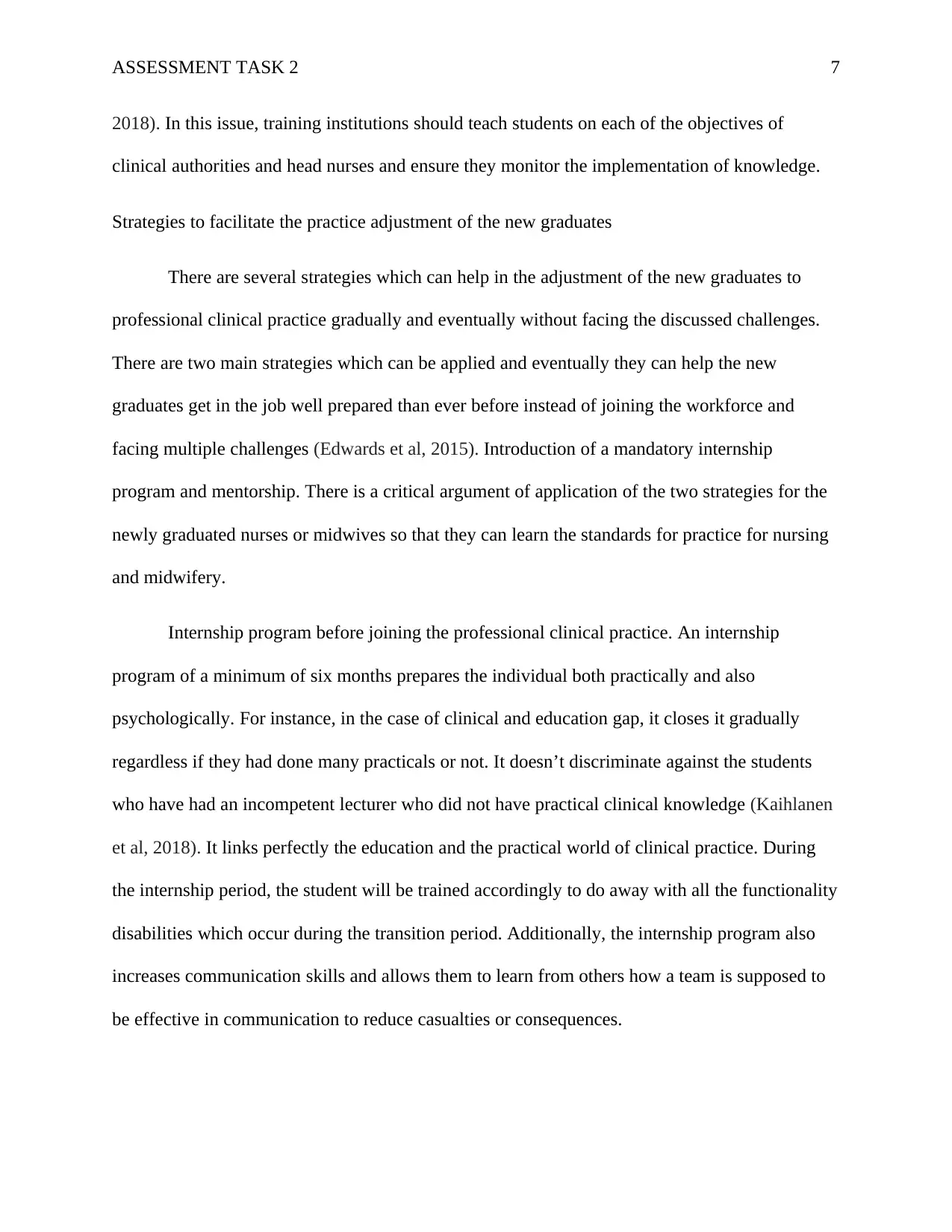
ASSESSMENT TASK 2 7
2018). In this issue, training institutions should teach students on each of the objectives of
clinical authorities and head nurses and ensure they monitor the implementation of knowledge.
Strategies to facilitate the practice adjustment of the new graduates
There are several strategies which can help in the adjustment of the new graduates to
professional clinical practice gradually and eventually without facing the discussed challenges.
There are two main strategies which can be applied and eventually they can help the new
graduates get in the job well prepared than ever before instead of joining the workforce and
facing multiple challenges (Edwards et al, 2015). Introduction of a mandatory internship
program and mentorship. There is a critical argument of application of the two strategies for the
newly graduated nurses or midwives so that they can learn the standards for practice for nursing
and midwifery.
Internship program before joining the professional clinical practice. An internship
program of a minimum of six months prepares the individual both practically and also
psychologically. For instance, in the case of clinical and education gap, it closes it gradually
regardless if they had done many practicals or not. It doesn’t discriminate against the students
who have had an incompetent lecturer who did not have practical clinical knowledge (Kaihlanen
et al, 2018). It links perfectly the education and the practical world of clinical practice. During
the internship period, the student will be trained accordingly to do away with all the functionality
disabilities which occur during the transition period. Additionally, the internship program also
increases communication skills and allows them to learn from others how a team is supposed to
be effective in communication to reduce casualties or consequences.
2018). In this issue, training institutions should teach students on each of the objectives of
clinical authorities and head nurses and ensure they monitor the implementation of knowledge.
Strategies to facilitate the practice adjustment of the new graduates
There are several strategies which can help in the adjustment of the new graduates to
professional clinical practice gradually and eventually without facing the discussed challenges.
There are two main strategies which can be applied and eventually they can help the new
graduates get in the job well prepared than ever before instead of joining the workforce and
facing multiple challenges (Edwards et al, 2015). Introduction of a mandatory internship
program and mentorship. There is a critical argument of application of the two strategies for the
newly graduated nurses or midwives so that they can learn the standards for practice for nursing
and midwifery.
Internship program before joining the professional clinical practice. An internship
program of a minimum of six months prepares the individual both practically and also
psychologically. For instance, in the case of clinical and education gap, it closes it gradually
regardless if they had done many practicals or not. It doesn’t discriminate against the students
who have had an incompetent lecturer who did not have practical clinical knowledge (Kaihlanen
et al, 2018). It links perfectly the education and the practical world of clinical practice. During
the internship period, the student will be trained accordingly to do away with all the functionality
disabilities which occur during the transition period. Additionally, the internship program also
increases communication skills and allows them to learn from others how a team is supposed to
be effective in communication to reduce casualties or consequences.
Paraphrase This Document
Need a fresh take? Get an instant paraphrase of this document with our AI Paraphraser
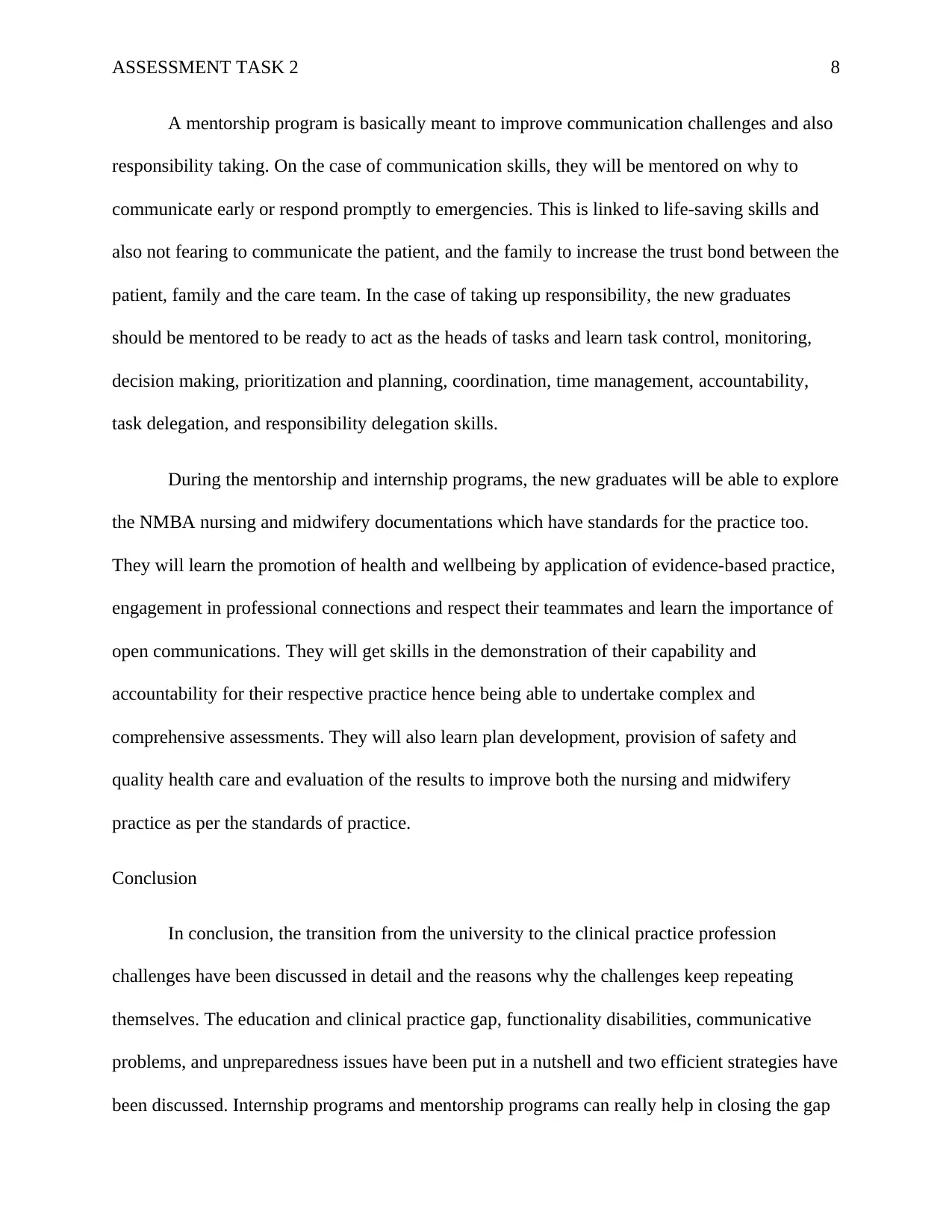
ASSESSMENT TASK 2 8
A mentorship program is basically meant to improve communication challenges and also
responsibility taking. On the case of communication skills, they will be mentored on why to
communicate early or respond promptly to emergencies. This is linked to life-saving skills and
also not fearing to communicate the patient, and the family to increase the trust bond between the
patient, family and the care team. In the case of taking up responsibility, the new graduates
should be mentored to be ready to act as the heads of tasks and learn task control, monitoring,
decision making, prioritization and planning, coordination, time management, accountability,
task delegation, and responsibility delegation skills.
During the mentorship and internship programs, the new graduates will be able to explore
the NMBA nursing and midwifery documentations which have standards for the practice too.
They will learn the promotion of health and wellbeing by application of evidence-based practice,
engagement in professional connections and respect their teammates and learn the importance of
open communications. They will get skills in the demonstration of their capability and
accountability for their respective practice hence being able to undertake complex and
comprehensive assessments. They will also learn plan development, provision of safety and
quality health care and evaluation of the results to improve both the nursing and midwifery
practice as per the standards of practice.
Conclusion
In conclusion, the transition from the university to the clinical practice profession
challenges have been discussed in detail and the reasons why the challenges keep repeating
themselves. The education and clinical practice gap, functionality disabilities, communicative
problems, and unpreparedness issues have been put in a nutshell and two efficient strategies have
been discussed. Internship programs and mentorship programs can really help in closing the gap
A mentorship program is basically meant to improve communication challenges and also
responsibility taking. On the case of communication skills, they will be mentored on why to
communicate early or respond promptly to emergencies. This is linked to life-saving skills and
also not fearing to communicate the patient, and the family to increase the trust bond between the
patient, family and the care team. In the case of taking up responsibility, the new graduates
should be mentored to be ready to act as the heads of tasks and learn task control, monitoring,
decision making, prioritization and planning, coordination, time management, accountability,
task delegation, and responsibility delegation skills.
During the mentorship and internship programs, the new graduates will be able to explore
the NMBA nursing and midwifery documentations which have standards for the practice too.
They will learn the promotion of health and wellbeing by application of evidence-based practice,
engagement in professional connections and respect their teammates and learn the importance of
open communications. They will get skills in the demonstration of their capability and
accountability for their respective practice hence being able to undertake complex and
comprehensive assessments. They will also learn plan development, provision of safety and
quality health care and evaluation of the results to improve both the nursing and midwifery
practice as per the standards of practice.
Conclusion
In conclusion, the transition from the university to the clinical practice profession
challenges have been discussed in detail and the reasons why the challenges keep repeating
themselves. The education and clinical practice gap, functionality disabilities, communicative
problems, and unpreparedness issues have been put in a nutshell and two efficient strategies have
been discussed. Internship programs and mentorship programs can really help in closing the gap
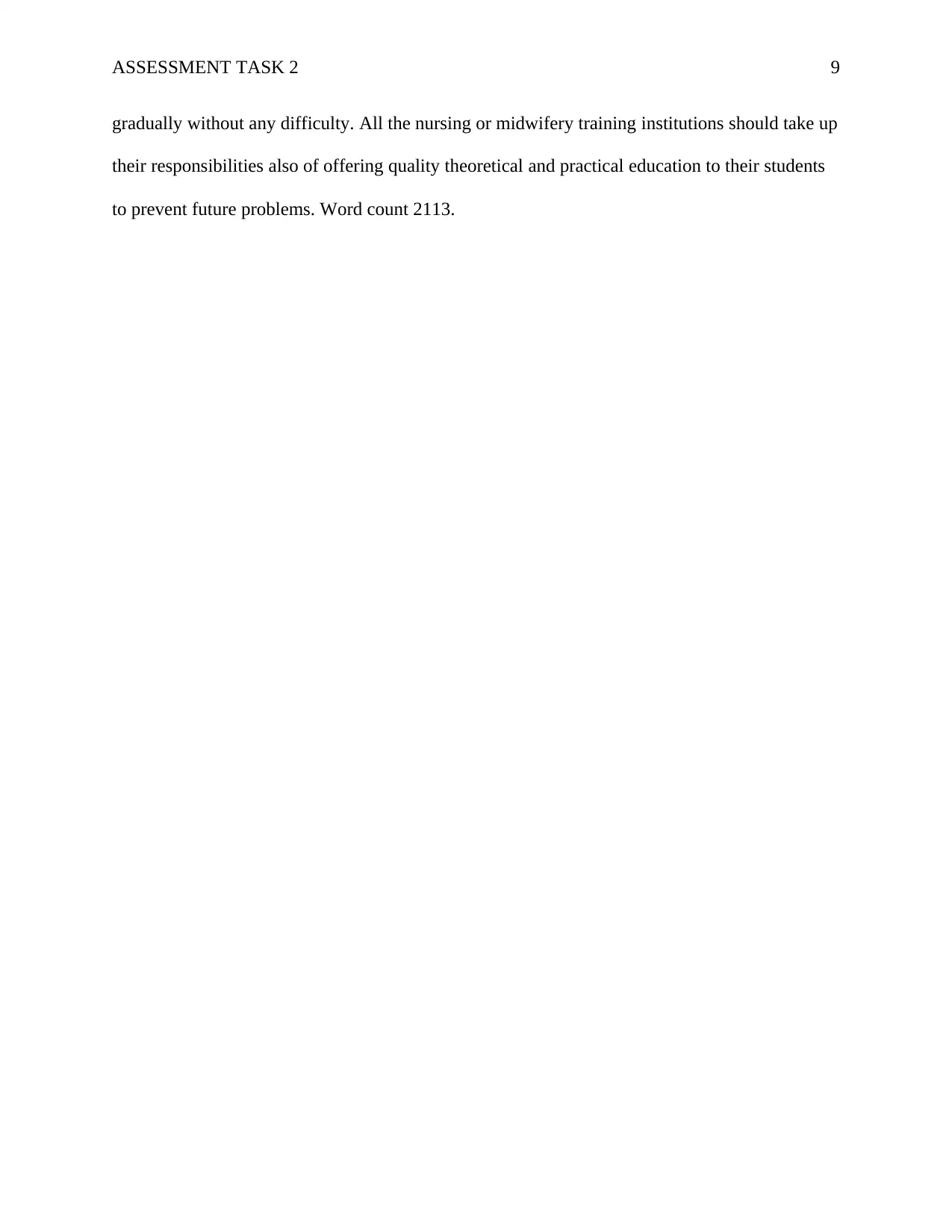
ASSESSMENT TASK 2 9
gradually without any difficulty. All the nursing or midwifery training institutions should take up
their responsibilities also of offering quality theoretical and practical education to their students
to prevent future problems. Word count 2113.
gradually without any difficulty. All the nursing or midwifery training institutions should take up
their responsibilities also of offering quality theoretical and practical education to their students
to prevent future problems. Word count 2113.
⊘ This is a preview!⊘
Do you want full access?
Subscribe today to unlock all pages.

Trusted by 1+ million students worldwide
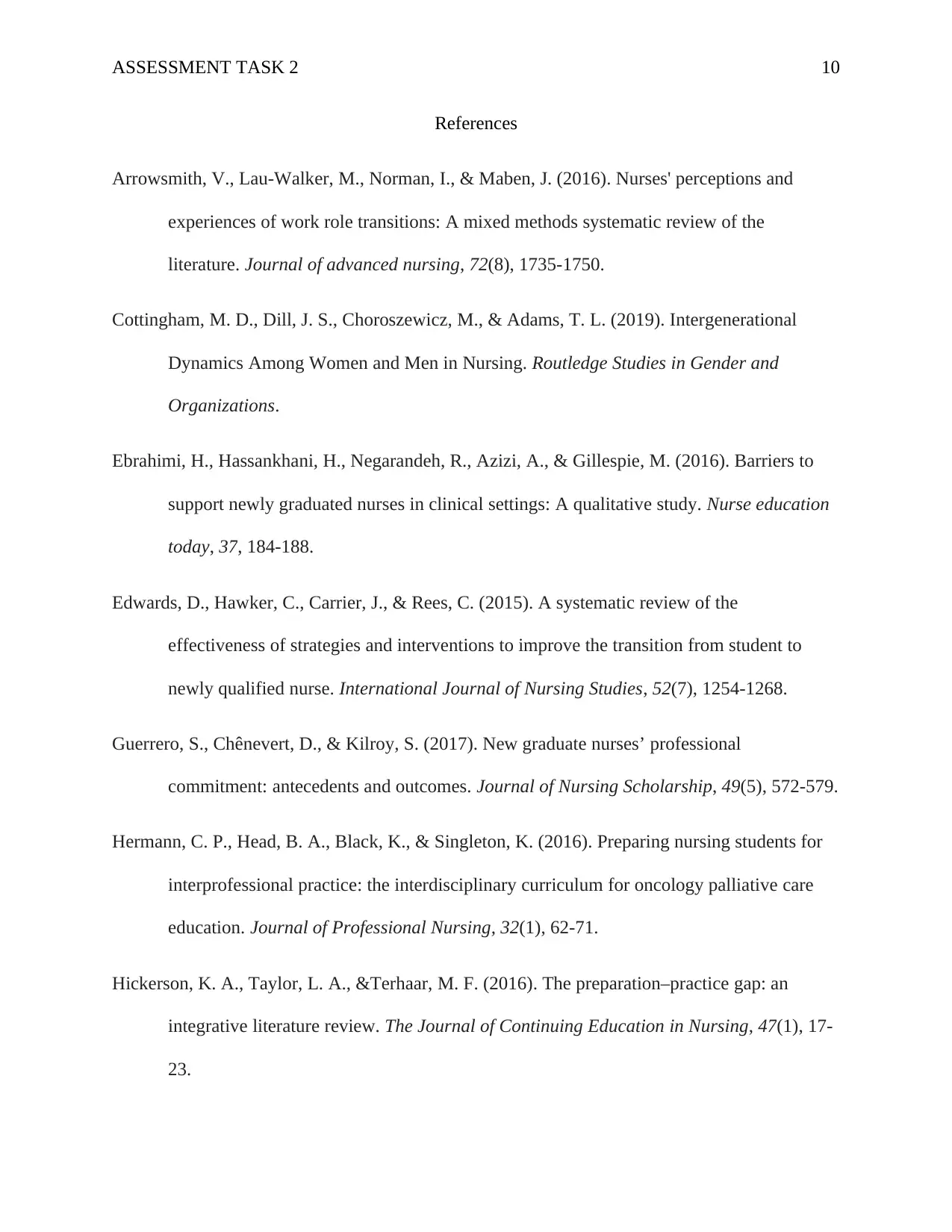
ASSESSMENT TASK 2 10
References
Arrowsmith, V., Lau‐Walker, M., Norman, I., & Maben, J. (2016). Nurses' perceptions and
experiences of work role transitions: A mixed methods systematic review of the
literature. Journal of advanced nursing, 72(8), 1735-1750.
Cottingham, M. D., Dill, J. S., Choroszewicz, M., & Adams, T. L. (2019). Intergenerational
Dynamics Among Women and Men in Nursing. Routledge Studies in Gender and
Organizations.
Ebrahimi, H., Hassankhani, H., Negarandeh, R., Azizi, A., & Gillespie, M. (2016). Barriers to
support newly graduated nurses in clinical settings: A qualitative study. Nurse education
today, 37, 184-188.
Edwards, D., Hawker, C., Carrier, J., & Rees, C. (2015). A systematic review of the
effectiveness of strategies and interventions to improve the transition from student to
newly qualified nurse. International Journal of Nursing Studies, 52(7), 1254-1268.
Guerrero, S., Chênevert, D., & Kilroy, S. (2017). New graduate nurses’ professional
commitment: antecedents and outcomes. Journal of Nursing Scholarship, 49(5), 572-579.
Hermann, C. P., Head, B. A., Black, K., & Singleton, K. (2016). Preparing nursing students for
interprofessional practice: the interdisciplinary curriculum for oncology palliative care
education. Journal of Professional Nursing, 32(1), 62-71.
Hickerson, K. A., Taylor, L. A., &Terhaar, M. F. (2016). The preparation–practice gap: an
integrative literature review. The Journal of Continuing Education in Nursing, 47(1), 17-
23.
References
Arrowsmith, V., Lau‐Walker, M., Norman, I., & Maben, J. (2016). Nurses' perceptions and
experiences of work role transitions: A mixed methods systematic review of the
literature. Journal of advanced nursing, 72(8), 1735-1750.
Cottingham, M. D., Dill, J. S., Choroszewicz, M., & Adams, T. L. (2019). Intergenerational
Dynamics Among Women and Men in Nursing. Routledge Studies in Gender and
Organizations.
Ebrahimi, H., Hassankhani, H., Negarandeh, R., Azizi, A., & Gillespie, M. (2016). Barriers to
support newly graduated nurses in clinical settings: A qualitative study. Nurse education
today, 37, 184-188.
Edwards, D., Hawker, C., Carrier, J., & Rees, C. (2015). A systematic review of the
effectiveness of strategies and interventions to improve the transition from student to
newly qualified nurse. International Journal of Nursing Studies, 52(7), 1254-1268.
Guerrero, S., Chênevert, D., & Kilroy, S. (2017). New graduate nurses’ professional
commitment: antecedents and outcomes. Journal of Nursing Scholarship, 49(5), 572-579.
Hermann, C. P., Head, B. A., Black, K., & Singleton, K. (2016). Preparing nursing students for
interprofessional practice: the interdisciplinary curriculum for oncology palliative care
education. Journal of Professional Nursing, 32(1), 62-71.
Hickerson, K. A., Taylor, L. A., &Terhaar, M. F. (2016). The preparation–practice gap: an
integrative literature review. The Journal of Continuing Education in Nursing, 47(1), 17-
23.
Paraphrase This Document
Need a fresh take? Get an instant paraphrase of this document with our AI Paraphraser
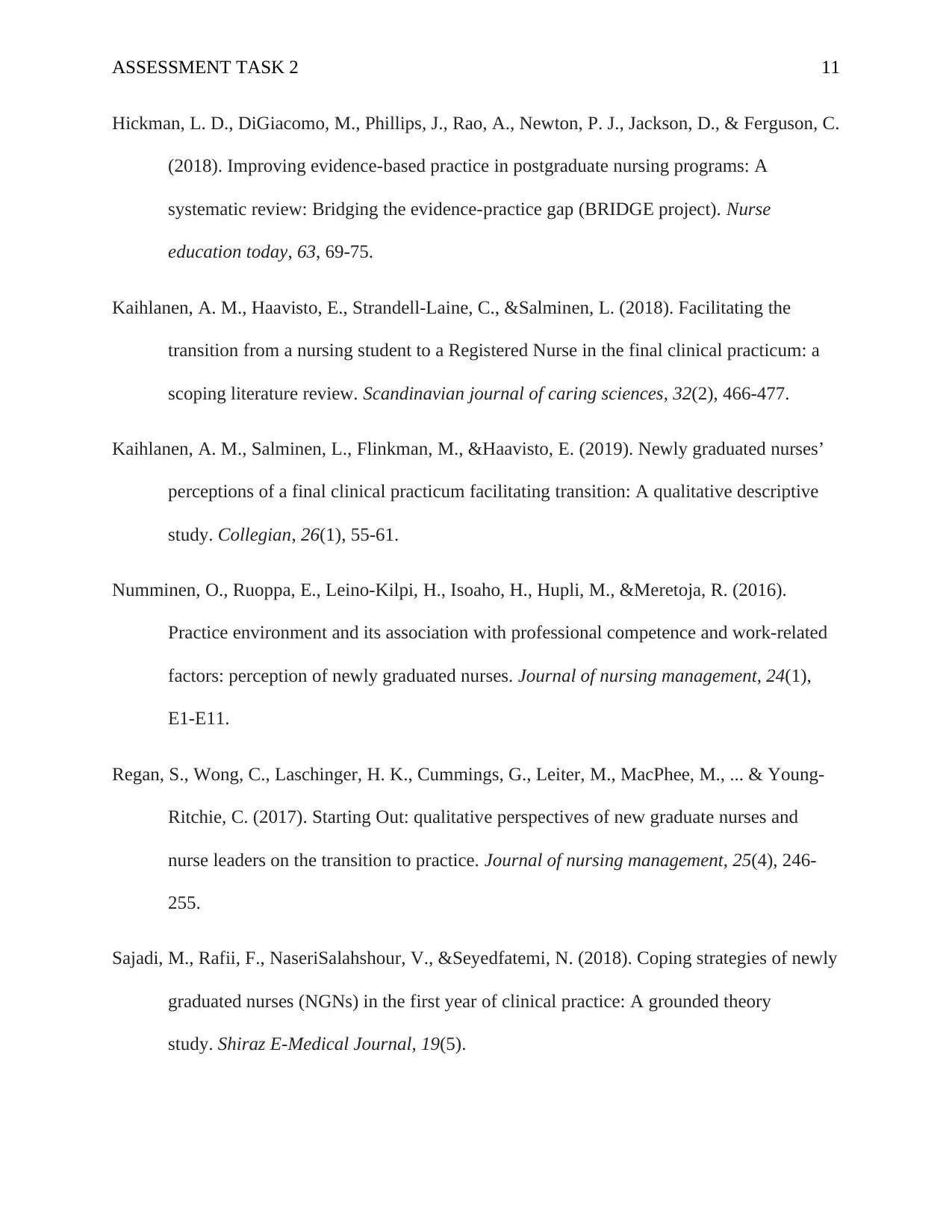
ASSESSMENT TASK 2 11
Hickman, L. D., DiGiacomo, M., Phillips, J., Rao, A., Newton, P. J., Jackson, D., & Ferguson, C.
(2018). Improving evidence-based practice in postgraduate nursing programs: A
systematic review: Bridging the evidence-practice gap (BRIDGE project). Nurse
education today, 63, 69-75.
Kaihlanen, A. M., Haavisto, E., Strandell‐Laine, C., &Salminen, L. (2018). Facilitating the
transition from a nursing student to a Registered Nurse in the final clinical practicum: a
scoping literature review. Scandinavian journal of caring sciences, 32(2), 466-477.
Kaihlanen, A. M., Salminen, L., Flinkman, M., &Haavisto, E. (2019). Newly graduated nurses’
perceptions of a final clinical practicum facilitating transition: A qualitative descriptive
study. Collegian, 26(1), 55-61.
Numminen, O., Ruoppa, E., Leino‐Kilpi, H., Isoaho, H., Hupli, M., &Meretoja, R. (2016).
Practice environment and its association with professional competence and work‐related
factors: perception of newly graduated nurses. Journal of nursing management, 24(1),
E1-E11.
Regan, S., Wong, C., Laschinger, H. K., Cummings, G., Leiter, M., MacPhee, M., ... & Young‐
Ritchie, C. (2017). Starting Out: qualitative perspectives of new graduate nurses and
nurse leaders on the transition to practice. Journal of nursing management, 25(4), 246-
255.
Sajadi, M., Rafii, F., NaseriSalahshour, V., &Seyedfatemi, N. (2018). Coping strategies of newly
graduated nurses (NGNs) in the first year of clinical practice: A grounded theory
study. Shiraz E-Medical Journal, 19(5).
Hickman, L. D., DiGiacomo, M., Phillips, J., Rao, A., Newton, P. J., Jackson, D., & Ferguson, C.
(2018). Improving evidence-based practice in postgraduate nursing programs: A
systematic review: Bridging the evidence-practice gap (BRIDGE project). Nurse
education today, 63, 69-75.
Kaihlanen, A. M., Haavisto, E., Strandell‐Laine, C., &Salminen, L. (2018). Facilitating the
transition from a nursing student to a Registered Nurse in the final clinical practicum: a
scoping literature review. Scandinavian journal of caring sciences, 32(2), 466-477.
Kaihlanen, A. M., Salminen, L., Flinkman, M., &Haavisto, E. (2019). Newly graduated nurses’
perceptions of a final clinical practicum facilitating transition: A qualitative descriptive
study. Collegian, 26(1), 55-61.
Numminen, O., Ruoppa, E., Leino‐Kilpi, H., Isoaho, H., Hupli, M., &Meretoja, R. (2016).
Practice environment and its association with professional competence and work‐related
factors: perception of newly graduated nurses. Journal of nursing management, 24(1),
E1-E11.
Regan, S., Wong, C., Laschinger, H. K., Cummings, G., Leiter, M., MacPhee, M., ... & Young‐
Ritchie, C. (2017). Starting Out: qualitative perspectives of new graduate nurses and
nurse leaders on the transition to practice. Journal of nursing management, 25(4), 246-
255.
Sajadi, M., Rafii, F., NaseriSalahshour, V., &Seyedfatemi, N. (2018). Coping strategies of newly
graduated nurses (NGNs) in the first year of clinical practice: A grounded theory
study. Shiraz E-Medical Journal, 19(5).
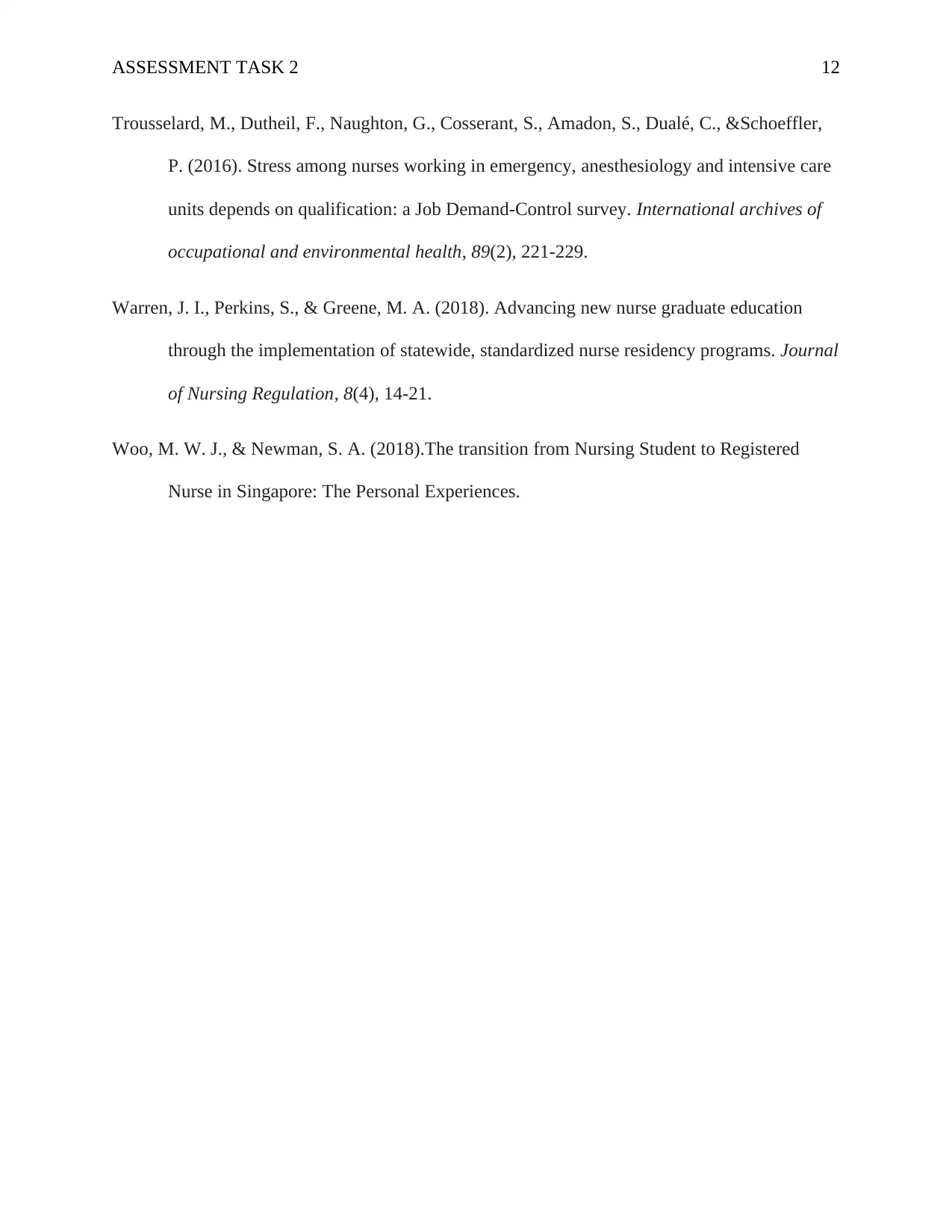
ASSESSMENT TASK 2 12
Trousselard, M., Dutheil, F., Naughton, G., Cosserant, S., Amadon, S., Dualé, C., &Schoeffler,
P. (2016). Stress among nurses working in emergency, anesthesiology and intensive care
units depends on qualification: a Job Demand-Control survey. International archives of
occupational and environmental health, 89(2), 221-229.
Warren, J. I., Perkins, S., & Greene, M. A. (2018). Advancing new nurse graduate education
through the implementation of statewide, standardized nurse residency programs. Journal
of Nursing Regulation, 8(4), 14-21.
Woo, M. W. J., & Newman, S. A. (2018).The transition from Nursing Student to Registered
Nurse in Singapore: The Personal Experiences.
Trousselard, M., Dutheil, F., Naughton, G., Cosserant, S., Amadon, S., Dualé, C., &Schoeffler,
P. (2016). Stress among nurses working in emergency, anesthesiology and intensive care
units depends on qualification: a Job Demand-Control survey. International archives of
occupational and environmental health, 89(2), 221-229.
Warren, J. I., Perkins, S., & Greene, M. A. (2018). Advancing new nurse graduate education
through the implementation of statewide, standardized nurse residency programs. Journal
of Nursing Regulation, 8(4), 14-21.
Woo, M. W. J., & Newman, S. A. (2018).The transition from Nursing Student to Registered
Nurse in Singapore: The Personal Experiences.
⊘ This is a preview!⊘
Do you want full access?
Subscribe today to unlock all pages.

Trusted by 1+ million students worldwide
1 out of 12
Related Documents
Your All-in-One AI-Powered Toolkit for Academic Success.
+13062052269
info@desklib.com
Available 24*7 on WhatsApp / Email
![[object Object]](/_next/static/media/star-bottom.7253800d.svg)
Unlock your academic potential
Copyright © 2020–2025 A2Z Services. All Rights Reserved. Developed and managed by ZUCOL.





